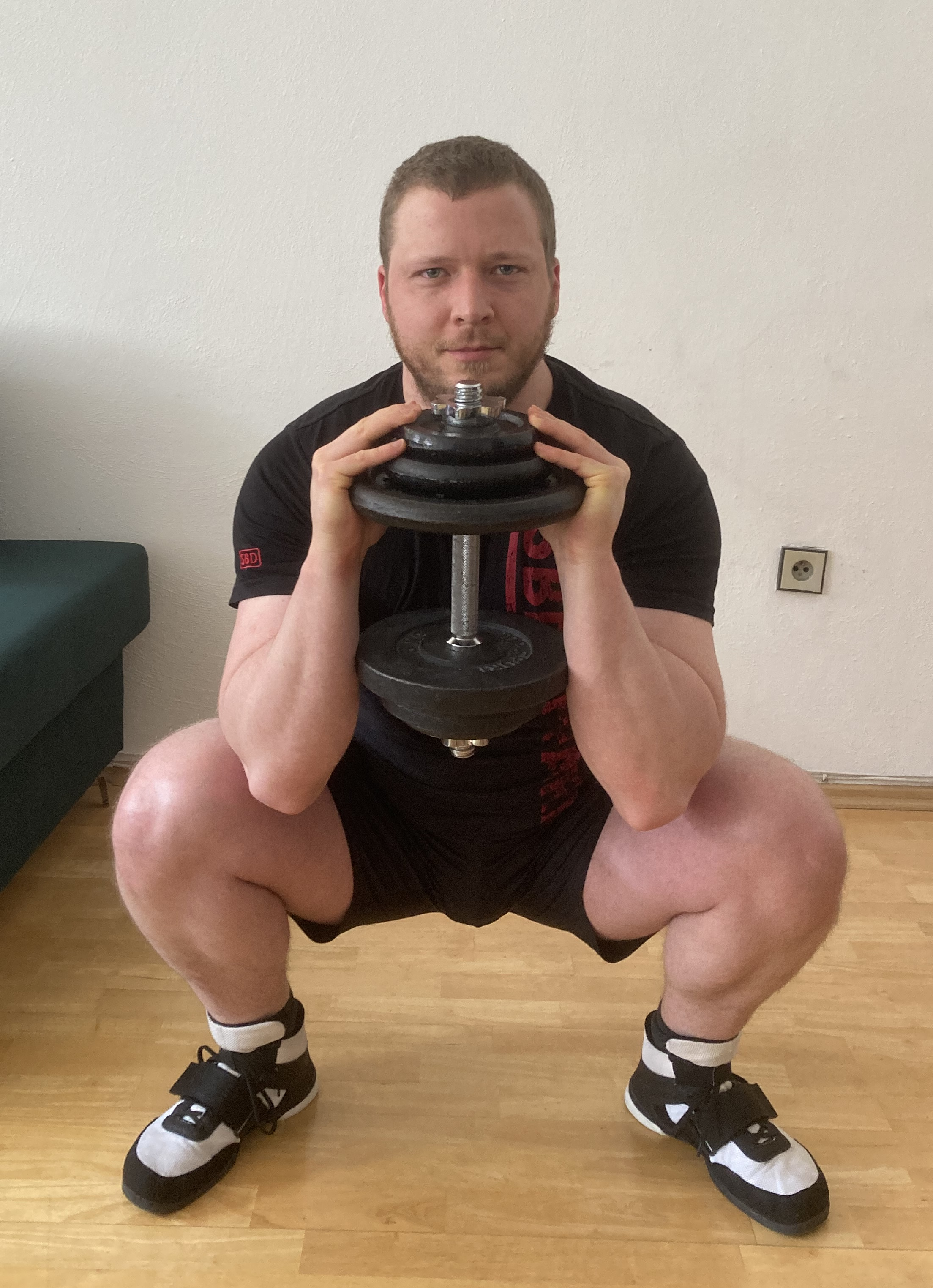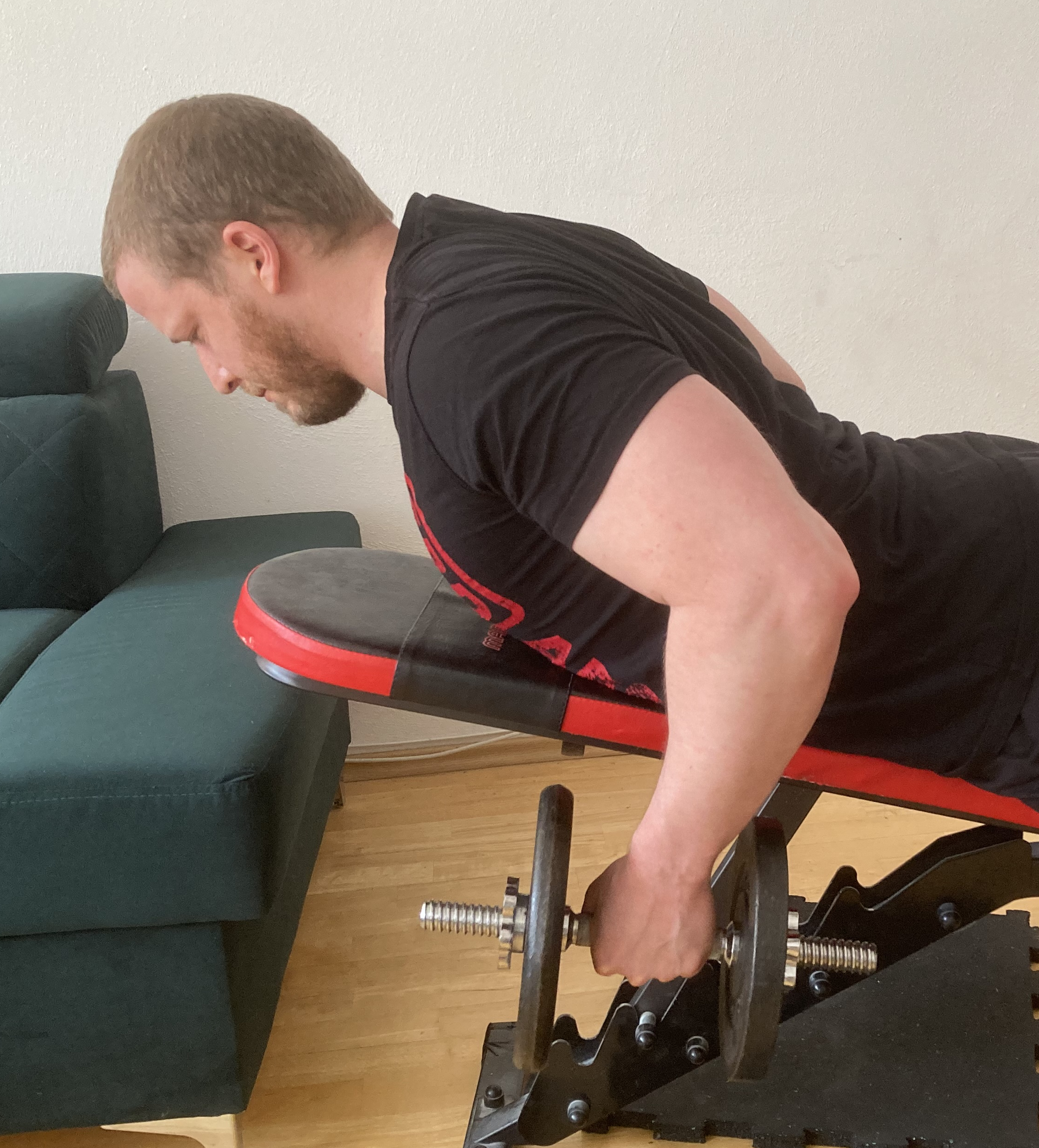What I do
Here I’m going to talk about how I proceed with my clients. I train English-speaking clients too. You just need to have at least a B2 level in English and some knowledge of training and nutrition vocabulary. You can get an idea of what to expect of me in the following article and whether to choose me. So here we go.
Training

First I go through a few basic exercises to determine where the weaknesses are or whether we need to work on mobility. In the following points, I will discuss what is most important to have mastered before we get to the specific focus of the training.
1. Goblet squat
After a first warm-up and stretching, I always start with this simple squat with a kettlebell or dumbbell. This variation will help you straighten your back and enable you to squat lower properly in combination with a wider stance. If that doesn’t do it, I’ll see what we need to work on right away. The most common issue is insufficient mobility in the hips and ankles and that causes a rounding of the back, the so-called „buttwink“. This is the first squat variation we need to master and then we can start with a harder one.
2. Interscapular muscles

A very important body part in today’s sedentary world. People often slouch, their shoulders go forward and their interscapular muscles are weak. This causes multiple problems – most notably, the humerus is pulled forward by the shortened pectoral muscles and can be a little dislocated from the joint socket. Combined with heavy pressing exercises, it causes pain at best, injury at worst. Further, the bent upper back transfers to the more bent lower back, which won’t be happy about it. We can also see this very often in gyms where many young guys do deadlifts with the “shitting dog” technique, but there are usually more issues present. We need to have this mastered before we get to anything harder. You can do multiple exercise variations, either with dumbbells or resistance bands.
3. Core muscles

A strong core is a must for pretty much anything, whether it’s a pain-free back or advanced strength training. The strong core muscles take quite a bit of the load off the lower back and protect it. A weak core is often the reason for their pain. In the beginning, I always try a few basic bodyweight exercises and make sure that the lower back is in a neutral position all the time, as this is the basic rule of all core exercises.
After mastering this you will have a great foundation for just about any type of training. Next, I’ll break down which workouts I can create and what you can expect from them:
1. Strength/bodybuilding training
This plan consists of two or three heavy exercises for strength, which means there are lower repetition ranges of 3-8 and then there are 2-4 exercises for bodybuilding purposes, where the repetition range is higher 8-20. This training routine is the best choice for functional strength and good muscle mass also. The training frequency can be a full body 3x a week, upper/lower body split 4x a week or push/pull split. The rest pauses between sets are between 1-3 minutes.
2. Bodybuilding training
Here we use a higher repetition range between 6-20, emphasis is placed on the contraction of the muscle and various intensification techniques can be used over time, such as slow negative repetitions, pauses in different phases of the exercise, superseries, or drop sets. The result is mainly aimed at quality muscle mass and overall appearance. The breaks between sets are between half a minute and two minutes.
3. Interval training
This training style of often preferred among women because it is focused more on firming and sculpting the body. The weights used are rather smaller, the exercises are alternated every set, the length of which is fixed and the pauses are short. I usually create this type of workout from 5-7 exercises with a set length of 30-60 seconds and a pause of 20-40 seconds for a total of 3-7 rounds. The length of the whole workout is variable between 30-60 minutes. This style of training burns a lot of calories because you don’t rest much and you’re working out consistently the whole time. Alternating exercises every series is quite demanding for the body energetically. The number of repetitions here is not fixed, but is guided by the motto “How many can you do with good technique in a given time”. However, alternating exercises in a public gym often doesn’t work very well, because no one likes to see someone taking up more equipment at once, so I tend to include exercises with body weight, kettlebells, and resistance bands. Due to the low equipment requirements, this training is also suitable for home workouts.
4. Cardio training
Most people can’t get away without it during weight loss. First and foremost, we need to think about how to incorporate more movement into our daily lives. The basis is certainly to walk more, either with your dog or to work. This is especially important for people who are mostly sedentary at work. The intensity should only be as high so you can still talk. If the pace is too intense, it is glucose that is burned and not fat. It’s always good when people choose the type of cardio they enjoy because that’s the only way they can stick with it for a long time. Getting your body in shape shouldn’t be a sprint and wanting everything right away, but it’s long-term consistent work.
Specialties

- The way to the first pull-up
- Improving technique and strength on the squat, bench press, and deadlift
- Preparation for competition in the deadlift
- Bodyweight training
- Resistance bands training
These types of training can be partially combined. It all depends on the client’s current shape and goals.
Nutrition plan
To create a tailored nutrition plan, I always need to find out the following information from the client:
- Current nutrition schedule of two or three days a week that are different from each other. It is necessary to write it down as accurately as possible, even down to the grams, and not to leave anything out. Without that, I can’t create it.
- The history of eating and especially the nutritional extremes
- Health restrictions and food intolerances
- The client’s food preferences, it’s always about creating a nutrition plan that also tastes good and can be sustained in the long term
I always try to teach clients to eat and build good habits for the long term, rather than slipping into short-term extremes that often damage health and/or lead to the yo-yo effect. Rather, I try to teach people to eat quality food, not to excessively lower the caloric, and to lose weight mainly through exercise.
